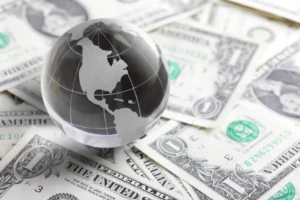The dominance of the US dollar as the world’s primary reserve currency has been a base of global finance for decades. Recent trends suggest a gradual shift in the realm of foreign exchange reserves. As the dollar’s share in global reserves declines, the rise of nontraditional currencies and geopolitical shifts indicate a potential transformation in the international monetary system. Is the US Dollar close to losing its world reserve currency status?
The Gradual Decline of the US Dollar
Recent data from the International Monetary Fund’s Currency Composition of Official Foreign Exchange Reserves (COFER) highlight a notable trend: a gradual decline in the dollar’s share of allocated foreign reserves held by central banks and governments. This decline has been ongoing over the last two decades, signaling a shift in the preferences of global reserve managers.

Interestingly, the reduced role of the US dollar has not been matched by corresponding increases in the shares of other major currencies, such as the euro, yen, and pound. Instead, there has been a significant rise in the share of nontraditional reserve currencies. These include the Australian dollar, Canadian dollar, Chinese renminbi, South Korean won, Singaporean dollar, and Nordic currencies.
The Rise of Nontraditional Reserve Currencies
The increasing prominence of nontraditional reserve currencies reflects a diversification strategy among central banks. This trend is partly driven by the desire to mitigate risks associated with over-reliance on a single currency. Central banks aim to enhance stability and reduce vulnerability to economic and geopolitical shocks by spreading their reserves across a broader range of currencies.
Additionally, financial sanctions have played a role in this shift. In recent years, central banks have moved modestly away from currencies that are susceptible to being frozen and redeployed, opting instead for assets like gold, which can be stored domestically and are free from sanctions risk. This move towards gold and nontraditional currencies marks a significant change in the composition of global reserves.

The Resurgence of the De-dollarization Movement
The concept of de-dollarization has gained renewed attention in recent years. De-dollarization refers to reducing reliance on the US dollar in international trade and finance. Various factors, including geopolitical tensions, economic uncertainties, and a desire for greater monetary sovereignty drive this movement.
Several countries have expressed interest in reducing their dependence on the dollar, seeking to shield their economies from the impact of US economic policies and sanctions. This trend is particularly evident among emerging economies, which are increasingly exploring alternative mechanisms for international transactions.
The Potential Emergence of a BRICS Currency
One of the most notable developments in the de-dollarization movement is the exploration of a unified currency among the BRICS nations—Brazil, Russia, India, China, and South Africa. These countries represent a significant portion of the world’s population, economic output, and natural resources. The idea of a BRICS currency, often referred to as a “BRICS basket,” has been proposed as a means to achieve greater monetary autonomy and strengthen economic cooperation within the bloc.
Proponents of a BRICS currency argue that it could facilitate trade and investment among member countries, reduce transaction costs, and provide a hedge against currency volatility. Moreover, it could symbolize collective strength and solidarity among emerging economies seeking to assert their influence on the global stage.
However, the implementation of a BRICS currency faces numerous challenges. The divergent economic structures and policy priorities of member countries complicate the establishment of a unified currency. Achieving consensus on issues such as exchange rate regimes, monetary policy frameworks, and capital controls would require delicate negotiations and compromise.

The Role of Cryptocurrencies
In addition to nontraditional reserve currencies, cryptocurrencies have also emerged as a potential factor influencing the dollar’s reserve status. While still in the early stages of adoption, cryptocurrencies like Bitcoin and Ethereum offer an alternative to traditional fiat currencies. Their decentralized nature and potential for cross-border transactions make them attractive to some as a hedge against currency volatility and geopolitical risks.
However, the integration of cryptocurrencies into global reserves is still limited by regulatory challenges, volatility, and concerns about security and stability. Nevertheless, the evolving landscape of digital currencies represents an area to watch in the context of reserve currency dynamics.

The landscape of global finance is undeniably shifting, and the US dollar’s position as the world’s primary reserve currency is increasingly under threat. The gradual decline in the dollar’s share of global reserves, coupled with the rise of nontraditional currencies and the resurgence of the de-dollarization movement, suggests that the era of dollar dominance may be nearing its end. The exploration of a BRICS currency and the growing interest in cryptocurrencies further underscores the desire for alternatives to the dollar. This transition will pose significant challenges but also opportunities for creating a more balanced and resilient global economy.
